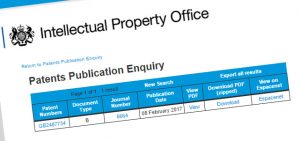[ad_1]
 GB Patent Number: GB2487734
GB Patent Number: GB2487734
Granted to: DXI Limited
This month’s patent is not necessarily the most revolutionary invention I’ve come across, but it provides an insight into something that touches each and every one of our lives.
It’s probably fair to say that most people consider telemarketing calls as a nuisance. There you are trying to enjoy some peace and quiet at home and the phone rings. Much to your annoyance it’s not a friend asking you out for dinner but a salesperson persistently trying to help you make a PPI claim, or just hack into your computer. Perhaps surprisingly however, it turns out there’s a lot of technology being implemented in these call centres.
Telemarketing companies employ an army of ‘agents’ to man their phones. Once upon a time the call centre would provide an agent with a list of phone numbers to plough through, but efficiency drives have made such lists a thing of the past, due to the time consuming and inaccurate nature of manual dialling. This led to the development of automated dialling systems, or merely ‘diallers’.
The next development was to separate the dialling operation from the agents’ telephone line. These ‘progressive diallers’ allow a computer to churn through and automatically call telephone numbers. The call is then connected to a free agent once the call has been answered by the unassuming target. By ensuring that only live connections are put through to an agent, productivity can be increased. Most people will be familiar with this when they experience a pause on answering the phone before hearing a voice at the other end of the line.
Further efficiencies can be achieved by using predictive diallers. These analyse call centre operation statistics and predict how many calls can be dialled simultaneously. For example, when an agent is free, or the system expects the agent to be free imminently, multiple numbers are called and then connected as and when they are answered. Such predictive diallers consider factors such as the expected talk time, the number of free agents and the likelihood that a dialled number will be answered.
A problem with predictive diallers is that they can dial too many numbers, some of which subsequently must be dropped.
For example, if the proportion of answered calls rises unexpectedly, or if some calls last longer than expected, there may not be any agents free to answer a connected call. It is, therefore, common practice to play a pre-recorded apology message when no agent is available. As you can imagine, such bogus calls cause annoyance to recipients and consequently telephone regulators, such as Ofcom, place limits on the number of abandoned calls that can be placed.
On many occasions when a call is connected it is not answered by a person but by an answer machine or automated answering service. Hence, many systems are designed to drop calls that are answered in this way. This technique is known as Answer Machine Detection and works by listening to the manner in which a call is answered. For example, a human normally answers a call with a short greeting such as ‘hello’, whereas answer machine greetings tend to be longer. However, this is not the most reliable means of detection.
Requiring an Answer Machine Detection system to listen to the first two seconds of a call before connecting it to a call handling agent causes a number of problems. For example, if during this time the Answer Machine Detection system incorrectly determines that the call is an answer machine then it will drop the call and abruptly cut-off the recipient.
This type of ‘silent call’ is also considered a nuisance and is measured by regulators. In the UK, Ofcom requires the number of such false positive disconnections to make up no more than 3% of calls per day, which can be challenging to achieve. Consequently, once a call centre gets close to this legal limit it will need to adapt its algorithms, with a knock-on effect on efficiency. Furthermore, Ofcom has the power to require call centres to manually listen to recordings of calls that have been designated ‘answered by a machine’ to determine the actual level of dropped calls, which can be onerous.
The UK Government takes this matter so seriously that in 2010 it increased the fines that Ofcom can impose for such breaches to £2m. Consequently, the invention described in GB patent no. 2487734, granted on 8 February 2017 aims to improve the detection accuracy of Answer Machine Detection systems.
DXI Limited has developed a technique, which they refer to as Network Level Binary Matching (NLBM). NLBM examines the binary data stream received from a called party and looks for matches with a library of stored binary data samples of known answer machine messages. The database is initially populated by manually listening to telephone calls when an answer machine is identified and others can be added to the library as and when they are detected.
In a similar fashion, when the binary data stream from an answered call does not match an existing library record it is automatically stored in a second database. If it is subsequently found that multiple data samples in this second database are identical then these would also be added to the first library. In this manner the NLBM system is ‘self-learning’.
As well as improving the detection accuracy of automated telesales systems, DXI’s invention will hopefully help to improve the experience of long-suffering call recipients too. Personally, however, I’d rather they just left me alone altogether!
Michael Jaeger is a partner and patent attorney at Withers & Rogers LLP, a leading firm of patent and trade mark attorneys.
[ad_2]
Source link
